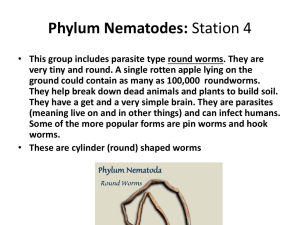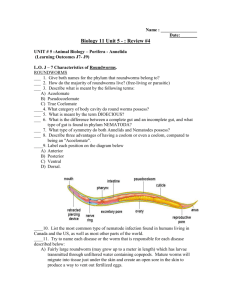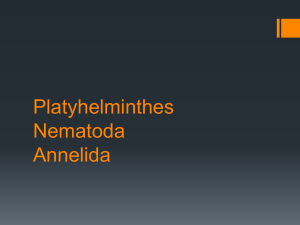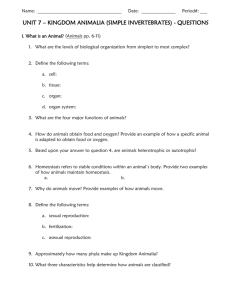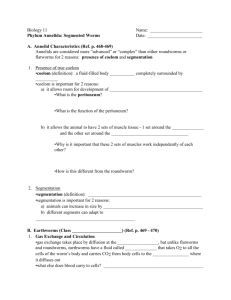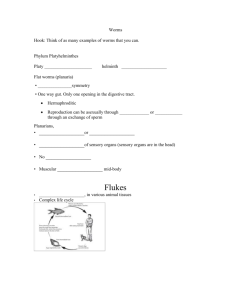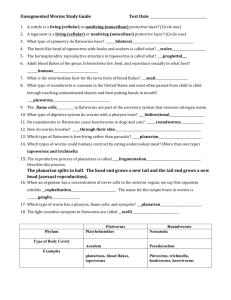True - Images
advertisement
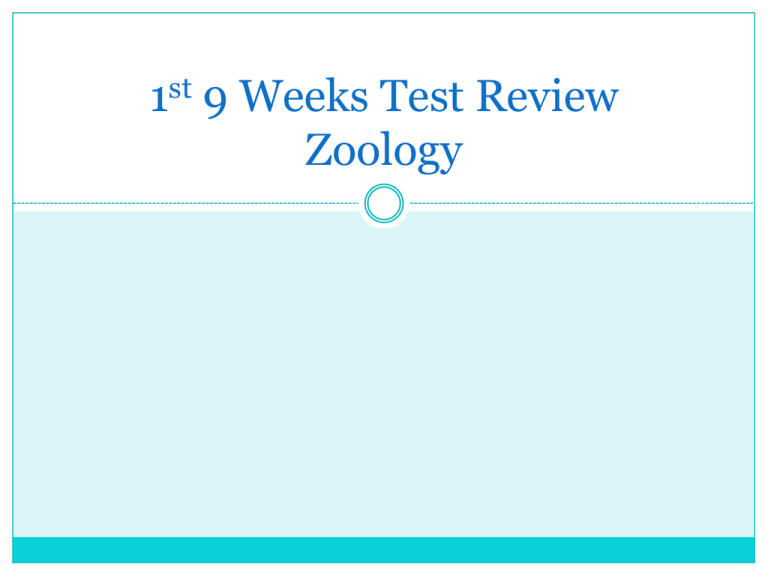
st 1 9 Weeks Test Review Zoology #1 The study of the kinds of organisms and the evolutionary relationships among them is Review SYSTEMATICS SHOW NEXT MARK FOR REVIEW #2 The classification system used today began with the work of Review CHARLES DARWIN SHOW NEXT MARK FOR REVIEW Each species has a unique name; #3 __________ is the assignment of these names. Review NOMENCLATURE SHOW NEXT MARK FOR REVIEW #4 What is the correct sequence (from broad/general to specific) of the major taxonomic categories? Review KINGDOM, PHYLUM, CLASS, ORDER, FAMILY, GENUS, SPECIES SHOW NEXT MARK FOR REVIEW #5 The standard for naming animals is Review THE INTERNATIONAL CODE OF ZOOLOGICAL NOMENCLATURE SHOW NEXT MARK FOR REVIEW #6 To designate a species correctly, the binomial nomenclature includes the __________ names. Review GENUS AND SPECIES NAME SHOW NEXT MARK FOR REVIEW #7 Describe how to correctly write a scientific name Review FIRST NAME CAPITALIZED, SECOND NAME LOWER CASE, ALL UNDERLINED OR ITALICIZED SHOW NEXT MARK FOR REVIEW #8. The "belly" (usually lower) surface of most bilaterally symmetrical animals is Review VENTRAL SHOW NEXT MARK FOR REVIEW The back (usually upper) surface of a bilateral animal is #9 Review DORSAL SHOW NEXT MARK FOR REVIEW #10 Formation of a distinct head is called Review CEPHALIZATION SHOW NEXT MARK FOR REVIEW #11 The end opposite the mouth is called the Review ABORAL SHOW NEXT MARK FOR REVIEW #12 The study of birds Review ORNITHOLOGY SHOW NEXT MARK FOR REVIEW #13 Review The study of fishes ICHTHYOLOGY SHOW NEXT MARK FOR REVIEW #14 The development of a coelom in an animal is always associated with Review TRIPLOBLASTIC ORGANIZATION SHOW NEXT MARK FOR REVIEW #15 A characteristic of __________ is early cleavage of the zygote. Review PROTOSTOME SHOW NEXT MARK FOR REVIEW #16 The first tissue level of organization is called __________. Review DIPLOBLASTIC SHOW NEXT MARK FOR REVIEW #17__________ is the absence of a central point or axis around which the body parts are equally distributed. Review ASYMMETRY SHOW NEXT MARK FOR REVIEW #18 Fate of embryonic cells is determined later on in the development of __________. Review DEUTEROSTOMES SHOW NEXT MARK FOR REVIEW An animal is found that is asymmetrical, has not tissues or organs, and is full of holes. This #19 animal is probably a Review SPONGE SHOW NEXT MARK FOR REVIEW #20 Which type of symmetry do roundworms have? Review BILATERAL SHOW NEXT MARK FOR REVIEW #21 a. acoelomate Roundworms are b. pseudocoelomate c. coelomate Review C SHOW NEXT MARK FOR REVIEW #22 Ascaris is an intestinal roundworm found in pigs and _____________. Review HUMANS SHOW NEXT MARK FOR REVIEW #23 What is the function of cilia on the anterior end of a rotifer? Review FEEDING SHOW NEXT MARK FOR REVIEW #24 What is the function of the mastax in rotifers? Review BREAKING DOWN OF FOOD SHOW NEXT MARK FOR REVIEW #25 The process of unfertilized eggs developing into an adult female (no males involved)! Review PARTHENOGENESIS SHOW NEXT MARK FOR REVIEW #26 Trichinella roundworm infection Review TRICHINOSIS SHOW NEXT MARK FOR REVIEW #27 Disease in which lymphatic vessels become blocked by larval worms. Review ELEPHANTIASIS SHOW NEXT MARK FOR REVIEW #28 Review Causes elephantiasis FILARIAL WORMS SHOW NEXT MARK FOR REVIEW #29 The roundworm digestive tract has how many openings? Review 2 SHOW NEXT MARK FOR REVIEW #30 A rotifer’s excretory system includes Review FLAME CELLS AND EXCRETORY TUBULES SHOW NEXT MARK FOR REVIEW #31 The Greek word “platyhelminthes” literally means Review FLAT WORM SHOW NEXT MARK FOR REVIEW Many of the worms in this #32 phylum have a head or head-like structure. What is this called? Review CEPHALIZATION SHOW NEXT MARK FOR REVIEW #33 Which class do planaria belong to and is mostly made up of free-living worms? Review CLASS TURBELLARIA SHOW NEXT MARK FOR REVIEW #34 How do planaria feed? Review PREDATORS SHOW NEXT MARK FOR REVIEW #35 These structures are simple eyes that detect light. Review OCELLI SHOW NEXT MARK FOR REVIEW #36 Which class contains tapeworms? Review CESTOIDEA SHOW NEXT MARK FOR REVIEW #37 Most members of phylum annelida live Review IN SALT WATER (MARINE) SHOW NEXT MARK FOR REVIEW #38 What type of symmetry do annelids have? Review BILATERAL SHOW NEXT MARK FOR REVIEW #39 What does it mean if an animal is “vermiform”? Review LONG AND SLENDER (WORMLIKE) SHOW NEXT MARK FOR REVIEW Nephridia are a part of the ___________system in Phylum Annelida. Review #40 EXCRETORY SHOW NEXT MARK FOR REVIEW Which of the following is used by a leech to disguise the bite when it attaches to a host? Review #41 ANESTHETIC SHOW NEXT MARK FOR REVIEW #42 Which of the following is used by a leech to keep blood from clotting inside its body once it is consumed? Review ANTICOAGULANT SHOW NEXT MARK FOR REVIEW #43 Which of the following body parts serves as the “anchor” during annelid movement? Review SETAE SHOW NEXT MARK FOR REVIEW #44 True or False Cephalization is usually associated with bilateral symmetry Review TRUE SHOW NEXT MARK FOR REVIEW True or False #45 A true coelom is advantageous because it can provide an area for storage and room Review for organ development. TRUE SHOW NEXT MARK FOR REVIEW #46 True or False A hermaphroditic animal is also known as dioecious. Review FALSE SHOW NEXT MARK FOR REVIEW #47 True or False Earthworms usually have an asexual life cycle. Review FALSE SHOW NEXT MARK FOR REVIEW #48 True or False Earthworms’ anterior segments are modified for sensing the environment, but are only capable of sensing light and not vibrations. Review FALSE SHOW NEXT MARK FOR REVIEW #49 True or False Two examples of marine annelids are bristle worms and fan worms. Review TRUE SHOW NEXT MARK FOR REVIEW •. #50 True or False Leeches are internal parasites. Review FASLE SHOW NEXT MARK FOR REVIEW #51 True or False The clitellum in earthworms is closer to the anterior end than the posterior end. Review TRUE SHOW NEXT MARK FOR REVIEW True or False #52 Earthworms are different from flatworms and roundworms because earthworms are segmented and are pseudocoelomates. Review FALSE SHOW NEXT MARK FOR REVIEW True or False #53 The Portuguese man of war is a floating colony of dangerous stinging polyps that cannot swim. Review TRUE SHOW NEXT MARK FOR REVIEW #54 True or False Hydra lacks the medusa stage, is small, and found in fresh very clean waters. Review TRUE SHOW NEXT MARK FOR REVIEW True or False Sponge cells are specialized, like other animals; however no tissues or organs exist. Review #55 TRUE SHOW NEXT MARK FOR REVIEW #56 Review True or False All flat worms are parasites FALSE SHOW NEXT MARK FOR REVIEW #57 True or False Each mature tapeworm can produce 80,000 eggs per day. Review TRUE SHOW NEXT MARK FOR REVIEW #58 True or False A host that harbors the immature stage of a parasite is called the definitive host. Review FALSE SHOW NEXT MARK FOR REVIEW True or False #59 Phylum Platyhelminthes is divided into four classes: Turbellaria, Monogenea, Review Trematoda, and Cestoidea. TRUE SHOW NEXT MARK FOR REVIEW #60 True or False Free-living flatworms cannot reproduce asexually by regeneration. Review FALSE SHOW NEXT MARK FOR REVIEW #61 True or False Rotifera is latin for “to bear a wheel”. Review TRUE SHOW NEXT MARK FOR REVIEW #62 True or False Nematodes are very small animals only ranging from 0.5mm to 3mm. Review FALSE SHOW NEXT MARK FOR REVIEW #63 True or False Parthenogenesis is derived from parenthenos meaning “virgin birth”. Review TRUE SHOW NEXT MARK FOR REVIEW #64 True or False Nematodes are also known as flatworms and members of the Phylum Platyhelminthes are known as roundworms. Review FALSE SHOW NEXT MARK FOR REVIEW #65 True or False In extreme cases, filiarisis can lead to elephantiasis, which is a grotesque swelling of the legs and other extremities due to worms blocking the lymphatic system. Review TRUE SHOW NEXT MARK FOR REVIEW Be sure to study the following vocabulary! bilateral symmetry class coelom family genus kingdom order phylum radial symmetry Species Asexual Reproduction Choanocytes (collar cells) Gastrovascular cavity Hydrostatic skeleton Medusa Nerve net Pinacocytes Polyp Sessile Corona Elephantiases Heartworm disease Lorina Mastax Microfilariae Clitellum Metamerism Parapodia Setae Tagmatization Crop The End END REVIEW
